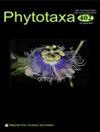Comolia paraensis(Melastomataceae),巴西帕拉州特有的一个引人注目的 Marcetieae 新种
IF 1
4区 生物学
Q3 PLANT SCIENCES
引用次数: 0
摘要
在编写 Comolia 分类学综述的过程中,我们发现了一些分类学上的新发现。在此,我们描述了巴西帕拉州特有的新物种 Comolia paraensis,该物种初步被列为濒危物种。该物种分布于奥里克西米纳(Oriximiná)周围的坎皮纳斯(campinas)以及阿雷格里山(Monte Alegre)和奥比多斯(Óbidos)的亚马逊石质稀树草原。Comolia paraensis 在形态上与 C. kuhlmannii 和 C. veronicifolia 相似,这两个分类实体在这里被认为与 C. villosa 不同。我们绘制了 Comolia paraensis 的插图,并将其与同类物种进行了比较,还介绍了它的地理分布和初步保护状况。我们还讨论了在来自阿雷格里山(Monte Alegre)的种群中发现的多汁现象,这在Marcetieae中是前所未有的,但在Pyramieae和Sonerileae中却很常见。本文章由计算机程序翻译,如有差异,请以英文原文为准。
Comolia paraensis (Melastomataceae), a striking new species of Marcetieae endemic to Pará, Brazil
During the preparation of the taxonomic review of Comolia, some taxonomic novelties were found. Here we describe Comolia paraensis, a new species endemic to the Brazilian state of Pará, preliminary categorized as Endangered. This species occurs in the campinas around Oriximiná and in the stony Amazonian savannas of Monte Alegre and Óbidos. Comolia paraensis is morphologically similar to C. kuhlmannii and C. veronicifolia, two taxonomic entities that here were considered distinct from C. villosa. Comolia paraensis is illustrated, compared with similar species, and notes on its geographic distribution and preliminary conservation status are provided. We also discuss the succulence found in the branches of the population from Monte Alegre, something unprecedented within Marcetieae, but commonly reported in Pyramieae and Sonerileae.
求助全文
通过发布文献求助,成功后即可免费获取论文全文。
去求助
来源期刊

Phytotaxa
PLANT SCIENCES-
CiteScore
1.90
自引率
27.30%
发文量
956
审稿时长
1 months
期刊介绍:
Phytotaxa is a peer-reviewed, international journal for rapid publication of high quality papers on any aspect of systematic and taxonomic botany, with a preference for large taxonomic works such as monographs, floras, revisions and evolutionary studies and descriptions of new taxa. Phytotaxa covers all groups covered by the International Code of Nomenclature foralgae, fungi, and plants ICNafp (fungi, lichens, algae, diatoms, mosses, liverworts, hornworts, and vascular plants), both living and fossil. Phytotaxa was founded in 2009 as botanical sister journal to Zootaxa. It has a large editorial board, who are running this journal on a voluntary basis, and it is published by Magnolia Press (Auckland , New Zealand). It is also indexed by SCIE, JCR and Biosis.
All types of taxonomic, floristic and phytogeographic papers are considered, including theoretical papers and methodology, systematics and phylogeny, monographs, revisions and reviews, catalogues, biographies and bibliographies, history of botanical explorations, identification guides, floras, analyses of characters, phylogenetic studies and phytogeography, descriptions of taxa, typification and nomenclatural papers. Monographs and other long manuscripts (of 60 printed pages or more) can be published as books, which will receive an ISBN number as well as being part of the Phytotaxa series.
 求助内容:
求助内容: 应助结果提醒方式:
应助结果提醒方式:


